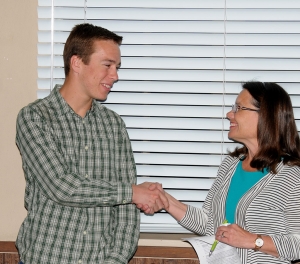|
New Law Makes School Expulsion/Suspension Parameters Clear
By Jean McLeod — Wednesday, March 19th, 2014
 Student of the Year Nick Johnson with Joann Dobbs At the March 18, 2014 Fillmore Unified School Board Meeting (FUSD) Attorney Aaron V. O'Donnell gave a presentation on a new California Law which requires all public school consider alternative methods when expelling a student for the first time and Superintendent Dr. Alan Nishino again spoke of the difficulties preparing for the upcoming Common Core State Standards Testing. Also, Student of the Year Nick Johnson was recognized for his accomplishments. The California legislature, in an attempt to provide equal access to education and stop what they consider the overuse of suspensions and expulsions, have written into law an alternatives to "immediate" suspensions and expulsions. O'Donnell explained the new California law (Cal Ed Code 48900.5(a) which states expulsion or suspension can only be used when other means of correction have been utilized and failed. The legislature introduced the law due to what they say are gross disparities in the manner in which suspensions and expulsion are being applied to students of color and those with disabilities. Schools must have a clear and consistently applied system for providing interventions prior to suspension or expulsion and ensure that students are not receiving different punishment for the same conduct. According to the California Department of Education (CDE) the total number of expulsions decreased by 12.3% along with a drop in suspensions by 14.1% from school years 2011-12 to 2012-13. "Gender can play a role in whether a student is suspended. Nationwide, more suspensions are given out to males than females. Male and female students each represent about half of the student population, however , males make up 66% of the students receiving a single out-of-school suspension and 74% of students expelled." The alternative methods CDE recommends school districts use are School-wide Positive Behavior Interventions and Support, along with the Restorative Justice approach, which was originally used in the justice system and emphasizes a sense of school community and positive relationships through the use of "restorative circles" where students and educators work together to set academic goals, develop core values for the classroom. Another method is Social Emotional Learning which teaches recognizing and managing emotions, developing and caring and concern for others by teaching socially acceptable behavior. Other means available, where appropriate, are a conference between school personnel, the student’s parents and the student, or referrals to school counselor or others in the field of professional counseling. Before a student can be expelled an investigation must be done which is not confined to just the accused and victim. The investigation must be done immediately and thoroughly. It must probe for specifics and find out exactly what happened and obtain written statements from everyone along with thorough notes. The students involved must be questioned and unlike a criminal case down at the police station, parents do not have to be present when their child is questioned; whether that questioning is by school staff or the police as long as it is on school grounds. Reasonable suspicion, not probable cause, is required to detain a student on school grounds to ask questions or conduct an investigation. All students are entitled to due process and may state their side of what happened. Schools may also adopt a policy authorizing teachers to require the parent(s) of the student suspended attend a portion of a school day in the classroom attended by their child. There are exceptions and they include; caused or attempted to cause or threaten to cause injury to another person, used force or violence except in self-defense, possessed, sold or furnished a gun, knife, explosive or other dangerous object, use of or sale of a controlled substance, theft of private or school property, sexual assault along with many others. Cyber bullying is also considered but only when all or some of it is conducted during school hours or school activities. When asked, "What is the incentive to not be a problem student, if a student knows the difficulty their school will have in suspending them?" O'Donnell responded "It's California law." But when asked again why problem students, knowing the law exists, where the incentive is to stop any disruptive behavior, knowing schools often will not want to go through the task required to deal with expelling or suspending them? O'Donnell said he had no answer. Early in the meeting, Superintendent Alan Nishino again commented on the Smarter Balance Testing that Common Core State Standards requires and the arduous task of supplying all the computers and technology needed in time for the first testing, stating "It's a huge undertaking." One teacher who was present at the meeting interjected, "It's not easy at all....my kids started last week." Nishino responded, "Nobody really knows (if everything will work) we start in two weeks (officially)...I'm keeping my fingers crossed." He went on to explain that some schools are having to divide the testing days with every other classroom testing that day due to the lack of bandwidth or computers. The board meeting began with recognition of Nick Johnson who was nominated for Student of the Year, but was unable to attend the last meeting where the honors were given out. Nick along with his parents Mary and Erik Johnson were introduced by Joann Dobbs Assistant Principal at Fillmore High School. Nick's name will be presented on a plaque with all the other Student of the Year awardees. |
